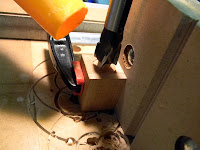They say that it's the little things that make a difference, and in this case it's knobs. Sometimes a store bought knob will work just fine but there are three problems. One, sometimes you can't find the right type of wood. Say you need curly maple or something, you're out of luck. Secondly, sometimes ( especially with cherry) you put them in and they never turn the same color, so you'll have four knobs that look great, two that look meh, and two that turn out terrible. And lastly, sometimes the machining just isn't all that good, off sized tenon, chipped, etc... So I make my own. This looks a lot better when lets say you have a dresser with graduated drawers. What you want is to have the knobs in proportion with the drawers, but with store-bought, you're stuck. But by making your own, you can tick up the size in relation to the drawer. Above you can see an assortment of knobs from various Shaker pieces. I chose the one on the right page, left hand column, second up from the bottom.

I laid out a diagram on some poster board so serve as a reference. I use it the same way as my leg story sticks, marking directly off the pattern to eliminate measuring errors.
Here you can see the cherry blocks that will become the knobs, roughly 1 1/2" by 1 1/2" by 2 1/2" tall. I marked out the center and cut the tenon with a tenon cutter, 1/2" thick by 7/8", which will allow the tenon to pass thru the drawer front and then be wedged from the back side. By doing that the knob will never come out. That's another problem with store bought, the tenons are short, and tapered, so they can't be wedged, and I'm not sure why they are tapered but it results in a poor glue up.
I did the pics in the wrong order, but above you can see the drilled block and on the right I cut away the ring, leaving the 1/2" by 7/8" long tenon. Below is the process for drilling, just clamp and drill. I had some doubts about the tenon cutter but it worked great.
And here's the finished knob. I put the tenon in the four-jaw chuck and parted the different depths, then turned it out. It is basically a big asymmetrical cove with a rounded off face. I cut the cove with a small detail gouge and turned off the face with the heel of a skew. A little sandpaper and its done.
Custom made means custom made, all the parts.
Note: I had a friend call me and ask about the rainbow cuff on the four-jaw chuck. You can get it at
Lee Valley for around 6 bucks, worth every penny. You'd spend more on band-aids if this thing bites you!!






















